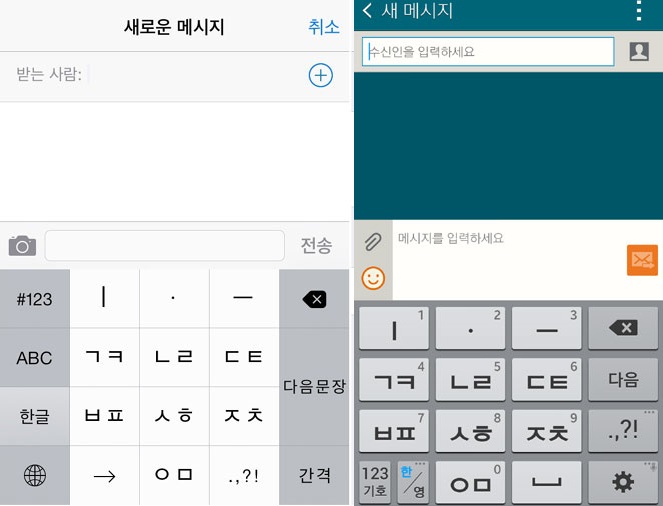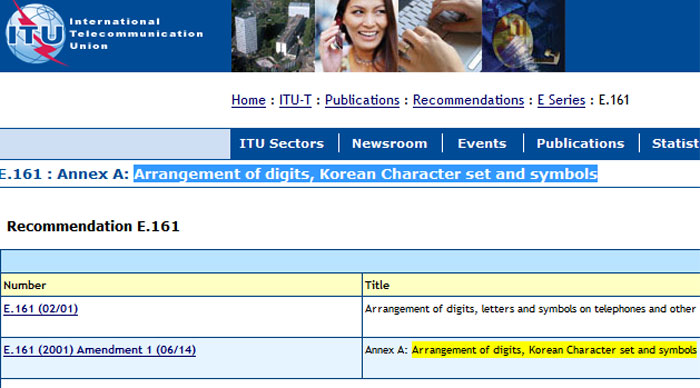The arrangement of Korean letters, syllabic blocks, digits and symbols has recently been newly added as an international standard used by the International Telecommunication Union (ITU).
At the ITU-T Study Group meeting in June this year, the Cheonjiin (천지인) system of arranging Korean letters on a digital keyboard was added to the list of international standards in the ITU’s E.161 report. The Cheonjiin system has now become an international standard for typing letters other than Latin, or Roman, letters, said the Ministry of Science, ICT & Future Planning. E.161 is an ITU-T list of recommendations that will help to define the way in which the basic 26 Latin letters (A to Z) are assigned to a 12-key telephone keypad.
With a physical keyboard, users can input letters, characters, numbers and other symbols and signs on an ordinary telephone, either wireless or land-line. Using keyboard software, however, people need to download the necessary application to their smart device to input their writing system of choice. Those who use a smart device made in a foreign country are able to download and use any keyboard software if it has been adopted as an international standard.

Currently, the Cheonjiin system of arranging Korean letters on a number pad is the most widely used letter input system in Korea. It is based on three letters: ㅣ, ㆍ and ㅡ. In the traditional Hangeul writing system, these symbolize humans, the sky and the earth, respectively. These three letters were designed so as to be able to represent all vowels used in Korean. Since being commercialized, users have praised the new input system. In 2011, it became Korea’s national standard for inputting Korean script. Apple's iPhone adopted the system with its iOs7 upgrade in June 2013.
The Korean ministry of science explained that it has been urging the ITU-T to standardize an input system apart from Latin. The ministry submitted its proposal to the World Telecommunication Standardization Assembly in December 2012. This has now led the addition of a Korean keyboard to the E.161 list of international standards.

By Yoon Sojung
Korea.net Staff Writer
arete@korea.kr

At the ITU-T Study Group meeting in June this year, the Cheonjiin (천지인) system of arranging Korean letters on a digital keyboard was added to the list of international standards in the ITU’s E.161 report. The Cheonjiin system has now become an international standard for typing letters other than Latin, or Roman, letters, said the Ministry of Science, ICT & Future Planning. E.161 is an ITU-T list of recommendations that will help to define the way in which the basic 26 Latin letters (A to Z) are assigned to a 12-key telephone keypad.
With a physical keyboard, users can input letters, characters, numbers and other symbols and signs on an ordinary telephone, either wireless or land-line. Using keyboard software, however, people need to download the necessary application to their smart device to input their writing system of choice. Those who use a smart device made in a foreign country are able to download and use any keyboard software if it has been adopted as an international standard.

The Cheonjiin system of arranging Korean letters on an Apple iPhone (left) and on a Samsung Galaxy.
Currently, the Cheonjiin system of arranging Korean letters on a number pad is the most widely used letter input system in Korea. It is based on three letters: ㅣ, ㆍ and ㅡ. In the traditional Hangeul writing system, these symbolize humans, the sky and the earth, respectively. These three letters were designed so as to be able to represent all vowels used in Korean. Since being commercialized, users have praised the new input system. In 2011, it became Korea’s national standard for inputting Korean script. Apple's iPhone adopted the system with its iOs7 upgrade in June 2013.
The Korean ministry of science explained that it has been urging the ITU-T to standardize an input system apart from Latin. The ministry submitted its proposal to the World Telecommunication Standardization Assembly in December 2012. This has now led the addition of a Korean keyboard to the E.161 list of international standards.

A captured image from the ITU's homepage shows the inclusion of Korean script in an amendment to the E.161 list.
By Yoon Sojung
Korea.net Staff Writer
arete@korea.kr